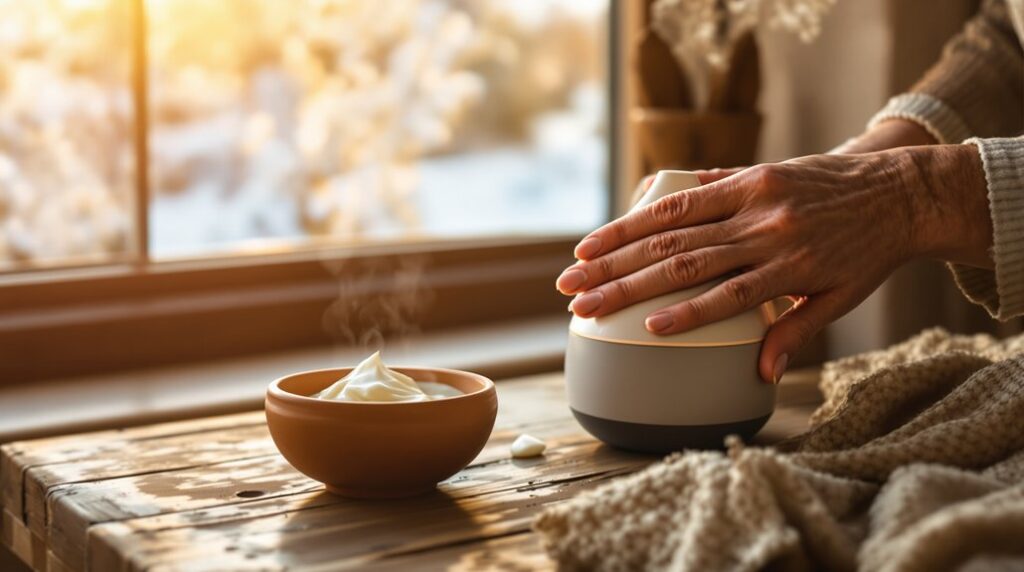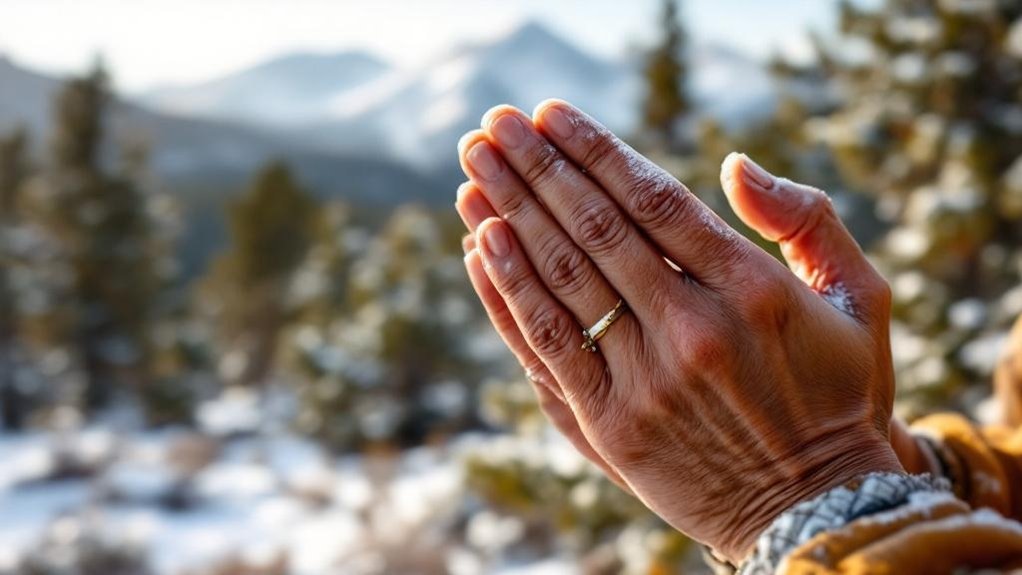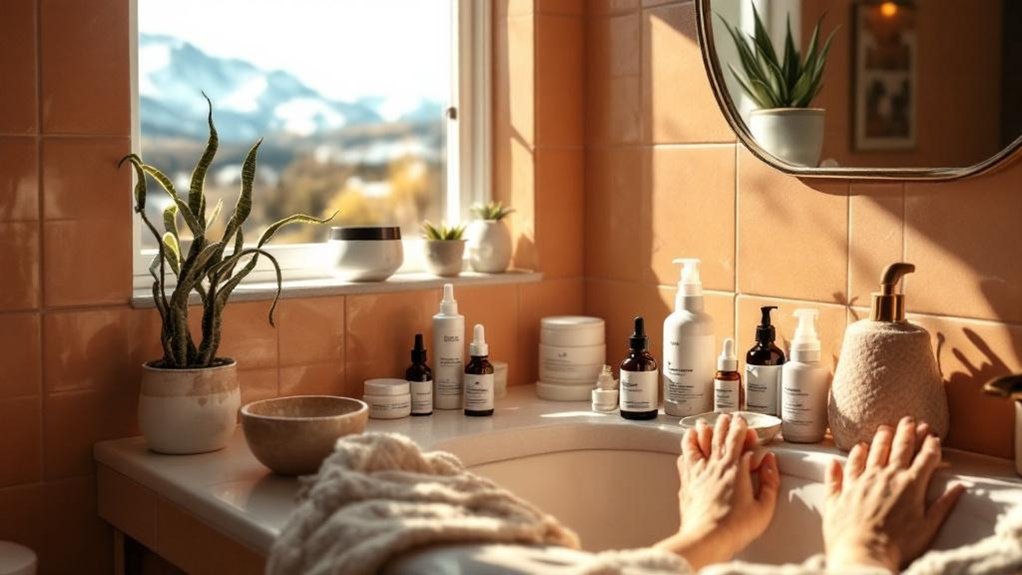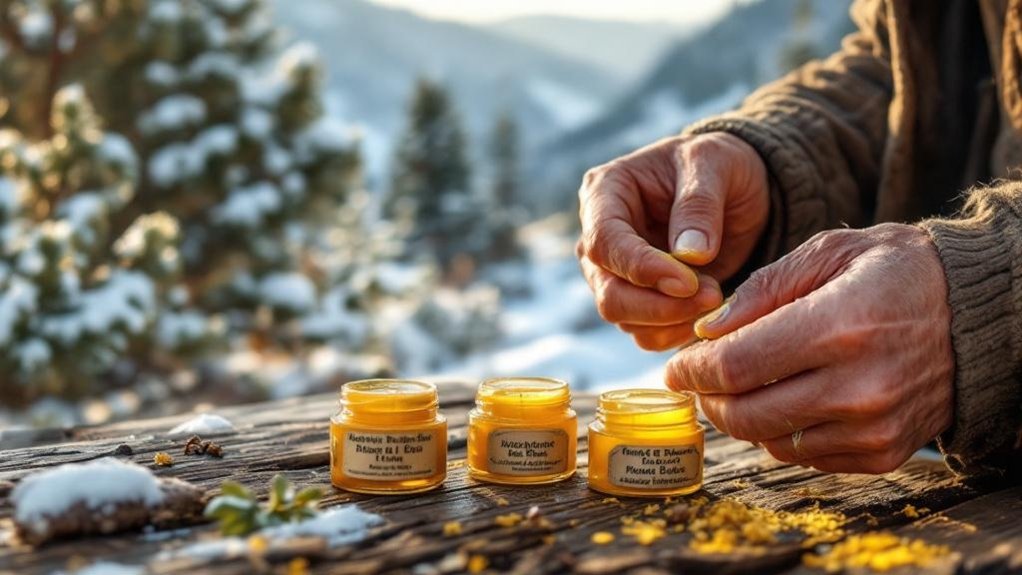Posted by: Skin And Cancer Institute in Cosmetic Procedures

New Mexico’s high desert winter demands specialized skincare strategies. We recommend combining humectants like hyaluronic acid with occlusive agents such as shea butter to trap moisture. Apply products on damp skin, use SPF 50+ daily (even on cloudy days), and maintain indoor humidity between 40-60% with strategically placed humidifiers. Gentle cleansers and ceramide-rich moisturizers are essential for repairing your skin’s barrier. These evidence-based approaches protect against the unique challenges of altitude, dryness, and intense UV exposure.
Key Takeaways
- Use broad-spectrum SPF 50+ daily as UV radiation increases by 8-10% per 1,000 feet of elevation.
- Layer humectants like hyaluronic acid on damp skin, then seal with occlusive ingredients like shea butter.
- Maintain indoor humidity between 40-60% with strategically placed humidifiers to combat winter dryness.
- Choose gentle cleansers and ceramide-rich moisturizers to strengthen your skin’s protective barrier against harsh desert conditions.
- Incorporate natural oils like jojoba or argan to replenish lipids and prevent moisture loss from wind and indoor heating.
Understanding the High Desert Climate’s Impact on Skin

While the high desert of New Mexico offers stunning landscapes and clear skies, its harsh climate presents unique challenges for skin health. The combination of high altitude, minimal humidity, and intense sun exposure creates a trifecta of skin stressors that can damage your winter skin barrier.
In our experience, the high desert wind resistance is particularly problematic during winter months. Strong winds strip moisture from the skin’s surface, while indoor heating further depletes essential hydration. This environmental assault weakens the skin’s protective barrier, leading to increased sensitivity, flaking, and discomfort.
We’ve observed that many patients develop chronic dryness, premature aging, and exacerbated skin conditions like eczema during this season. Similar to Arizona’s climate, this low humidity environment can trigger sebaceous glands to overproduce oils, creating a paradoxical cycle of dry yet acne-prone skin. Understanding these climate-specific challenges is essential for developing an effective skincare strategy tailored to New Mexico’s unique winter conditions.
Essential Ingredients for Desert Winter Moisturizers
We recommend using moisturizers that combine humectants like glycerin and hyaluronic acid to attract moisture with occlusives such as shea butter and dimethicone to seal it in.
Natural oil boosters including jojoba, argan, and squalane can effectively replenish the skin’s lipid barrier compromised by New Mexico’s dry winter air.
These ingredient combinations work synergistically to combat the high desert’s moisture-stripping effects while providing lasting hydration throughout the day.
Using a gentle exfoliator regularly helps these ingredients penetrate more deeply by removing dead skin cells that can block absorption.
Humectants vs. Occlusives
In the dry, high desert climate of New Mexico, understanding the difference between humectants and occlusives becomes essential for effective winter skin care.
Humectants like glycerin and hyaluronic acid draw moisture from the environment into your skin. But beware of humectant overuse when ambient humidity drops below 30%. Without sufficient environmental moisture to attract, humectants may actually pull water from deeper skin layers, worsening dryness.
Occlusives such as petrolatum, shea butter, and squalane create a protective barrier that prevents transepidermal water loss. We recommend occlusive layering during winter months—apply a humectant-based product to slightly damp skin, then seal with an occlusive moisturizer.
This combination approach helps maintain hydration even when indoor heating and harsh winds conspire to deplete your skin’s moisture reserves.
Natural Oil Boosters
Natural oils serve as powerful allies in combating the extreme dryness that plagues skin during New Mexico’s high desert winters. We recommend incorporating jojoba, argan, and rosehip oils into your daily routine, as these closely mimic the skin’s natural sebum while delivering concentrated nutrients.
Essential oils like lavender and chamomile can further enhance your moisturizer’s effectiveness when properly diluted, reducing inflammation while supporting your skin’s protective barrier.
For maximum benefit, apply facial serums containing these natural oil boosters to slightly damp skin before heavier creams.
We’ve found that patients who integrate these oils experience significant improvement in skin elasticity and hydration levels within two weeks.
Remember that consistency is key—even a small amount of these concentrated oils daily will help your skin withstand our region’s challenging winter conditions.
Morning and Night Skincare Routines for Extreme Dryness

When extreme dryness ravages your skin in New Mexico’s high desert, establishing consistent morning and night routines becomes essential for maintaining your skin barrier.
For winter wellness, start mornings with a gentle, hydrating cleanser followed by a hyaluronic acid serum while skin is still damp. Seal with a ceramide-rich moisturizer and broad-spectrum SPF 30+ protection, even on cloudy days.
Evenings call for more intensive care. After cleansing, apply prescription-strength retinoids sparingly, or alternate with glycolic acid to address flaking. Follow with a thicker emollient or overnight mask.
Consider running a humidifier to maintain indoor humidity between 40-60%, placing it near your bed to counteract overnight moisture loss. Be aware that environmental factors like heat and wind can trigger skin conditions such as rosacea, particularly during harsh desert winters.
Protecting Against High Altitude UV Exposure
UV radiation intensifies approximately 8-10% with every 1,000 feet of elevation gain, making New Mexico’s high desert environment particularly dangerous for skin health.
At elevations between 5,000-7,000 feet, our skin faces markedly higher UV exposure even during winter months when temperatures drop.
We recommend applying broad-spectrum SPF 50+ sunscreen daily, even on cloudy days. Don’t forget often-missed areas like ears, neck, and hands.
High altitude UV protection should include physical barriers too—wide-brimmed hats, UV-blocking sunglasses, and UPF-rated clothing provide essential protection during outdoor activities.
For our patients who enjoy winter hiking, skiing, or snowshoeing, remember that snow reflects up to 80% of UV rays, essentially doubling your exposure.
Reapply sunscreen every two hours when outdoors to maintain adequate protection in our uniquely challenging high desert climate.
Studies show that one severe sunburn can double your risk of developing melanoma later in life.
Healing Treatments for Cracked and Irritated Skin

The harsh desert environment of New Mexico often causes skin to become severely dehydrated, resulting in painful cracking and irritation during winter months. When cold wind exacerbates skin sensitivity, healing treatments become essential for recovery.
For immediate relief, we recommend medical-grade emollient creams containing ceramides and hyaluronic acid, which repair the skin barrier while retaining moisture. Apply these after showering when skin is slightly damp to lock in hydration.
For severely cracked areas, especially on hands and feet, overnight treatment with petroleum-based ointments under cotton gloves or socks can provide intensive repair.
Gentle exfoliation twice weekly helps remove damaged skin cells, allowing healing agents to penetrate more effectively.
Remember that consistency is key—regular application of these treatments will help maintain skin integrity throughout the challenging winter season. For persistent skin conditions, seeking care from board-certified dermatologists can provide specialized treatment plans tailored to your specific needs.
Hydration Strategies Beyond Topical Products
While topical moisturizers provide essential external hydration, maintaining healthy winter skin in New Mexico’s high desert requires extensive internal hydration strategies as well.
We recommend drinking at least eight glasses of water daily and incorporating omega-rich foods into your diet. Nutritional supplements containing hyaluronic acid, collagen, and vitamins E and D can notably improve skin elasticity and moisture retention from within.
Indoor humidifiers are vital investments for desert dwellers. These devices maintain ideal humidity levels (30-50%), preventing the excessive moisture loss that occurs in heated environments.
We suggest placing humidifiers in bedrooms and living areas where you spend the most time.
For maximum benefit, combine these internal hydration approaches with a consistent skincare routine that includes gentle cleansers and barrier-repairing moisturizers. For personalized treatment plans, our skilled dermatologists at The Skin and Cancer Institute can help address your unique skincare needs in challenging desert conditions.
Frequently Asked Questions
Can Certain Medications Increase Skin Sensitivity in High Desert Winters?
Yes, certain medications can cause side effects like increased skin sensitivity. We often see medication-induced reactions worsen in dry climates where skin reaction triggers are already abundant during winter months.
How Often Should I Exfoliate When Living in New Mexico?
We recommend exfoliating just 1-2 times weekly in New Mexico’s dry climate. Excessive exfoliation can damage your skin barrier. Desert skincare routines should prioritize gentle products and additional moisture between exfoliation sessions.
Are Humidifiers Effective for Desert Skin Conditions?
Yes, humidifiers are highly effective. We recommend them as essential hydration techniques for desert living. They help maintain skin barrier protection while you sleep, preventing moisture loss common in arid environments.
Which Fabrics Are Best for Preventing Winter Skin Irritation?
We recommend cotton, silk, and soft wool for their material breathability. Natural fiber choices reduce irritation by allowing skin to breathe while maintaining hydration. Avoid synthetic fabrics that can trap moisture against skin.
Should Skincare Routines Change During Seasonal Santa Fe Winds?
Yes, we recommend increasing moisturization during Santa Fe’s windy seasons. We advise applying ceramide-rich barriers for winter wind protection and maintaining desert sun defense with SPF, even on cloudy days.
Conclusion
We’ve outlined the most critical approaches to high desert winter skin care based on clinical evidence. By adjusting your routine to include proper moisturization, UV protection, and hydration strategies, you’ll maintain healthier skin despite New Mexico’s challenging climate. Remember that consistent prevention is more effective than treating damage after it occurs. If you’re experiencing persistent skin issues, don’t hesitate to schedule a consultation with our dermatologists.